Ankh
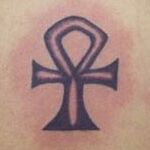 | The ancient Egyptian Hieroglyph is an example of a symbol that has completely transcended its culture and yet is uniquely associated with it. It was probably in use as early as 3000 B.C.E., a symbol associated with Imkotep, physician for the pharaoh's family, who later became a god of medicine and healing. Also known as the staff sign, the key of life, the key of the Nile, and the symbol for sexual union and for life, the ankh was associated with the Egyptian goddess Hathor and even with Christ as a symbol of eternal life. |
|
Ax
 | Since the Neolithis (or "New Stone") Age, the ax has been particularly symbolic of both battle and work. All ancient peoples seem to have used stone axes, and their use in creating sparks has perhaps led to their prevalent association with storms and with lightning, thunder, and rain. In tattoo imagery, the ax can stand alone or be integrated into a larger design. Their presence in most contexts, though, will draw upon their use as one of mankind's earliest weapons. |
|
Barbed Wire
 | Although originally created as a fencing material used in ranching in the American West in the late 1800s, barbed wire (also known as "barbwire" or "barb wire") has come to symbolize more than just the control of space and land. Because of its use in prison and war camp settings, it also carries a connotation of suffering, confinement, and capture. Its popularity in modern tattoo can be directly attributed to its use in armband styles and similarity to tribal styles, and also the 1996 movie Barb Wire, starring Pamela Anderson with her armband barbed wire tattoo. |
|
Bar Code
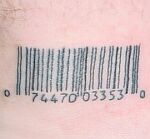 | The Bar Code, a means to present product information that can be quickly scanned by an optical computer system, was patented in 1952, but it wasn't until the late 70's that the system really started to take off. Today the bar code is everywhere, speeding up shopping and all manner of commerce. When used in tattoo, it is part of a symbolism that simultaneously emphasizes the need for individuality and the human body as a commodity. Its application on skin is ironic, where it presumably cannot be used for scanning purposes (although real information might be encoded in the tattoo), and pokes fun at the way we see ourselves and our bodies. |
|
Biohazard Symbol
 | The bioharzard warning symbol is a popular tattoo, owing in part to its intricate and interesting pattern, to its resemblance to tribal tattoo art, and to its meaning. It is internationally recognized as "the potential presence of a biohazard" (a biological substance that poses a hazard to humans). The symbol was developed by the Dow Chemicals Biohazards Research and Development team under contract with the National Cancer Institute (NCI), after the NCI decided that a warning symbol to enhance biohazard containment was critically needed. Read literally, a biohazard symbol marks the wearer as a hazard to humans. |
|
Buffalo Skull
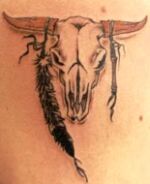 | Because the buffalo figured so largely in the Plains Indians' way of life and also in their mythology, it is no surprise to find that the buffalo skull played a role in their sacred rituals as well. Tattoo art that uses the buffalo skull frequently capitalizes on these associations by pairing it with other Plains Indians artifacts - beads, feathers, strips of leather, red paint. In Plains ritual, the buffalo skull was used as an altar, carried the buffalo's power, and even housed the Buffalo God, depending on the particular Plains group. It is therefore associalted with power both physical and supernatural. |
|
Butterfly
 | The butterfly is far and away the most-used insect image in all of tattoo. A symbolic creature in many cultures, it sometimes represents beauty itself or metamorphosis and other times the transitory nature of happiness and, indeed, all of life. To the Aztecs, the butterflysymbolized the soul or the breath of life exhaled by the dying. The same is true in classical antiquity, where it was a common belief that the soul left the body in the shape of a butterfly. In Western culture, butterflies are also seen as symbols of freedom. |
|
Celtic Cross
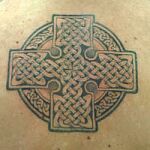 | The celtic cross, sometimes known as the wheel cross or the ring cross, which began to appear during the fifth century C.E., is a symbol of Christianity today, even though it may have been derived from much earlier pagan wheel symbols for the sun. Although most commonly used to mark gravestones in Ireland and Scotland, it was once used throughout Scandinavia, where it was erected at sites of violence or accident, as well as in front of farmhouses. It has, unfortunately, been adopted by neo-Nazi and white supremacist movements, including the Ku Klux Klan. |
|
Cherry
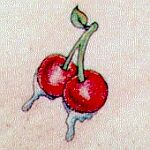 | Cherries have been used to symbolize feminine beauty as well as love and even divination. Inancient China they were a symbol of immortality or longevity. In Japan, the cherry was the samurai's symbol. For these warriors, the crushing of the fruit's flesh (to reach the hard pit within) was a symbol of sacrificing human flesh to get to the core of the person. In tattoo artwork, it is not uncommon to see the cherries paired, as they might come in nature. They can appear by themselves or sometimes in the mouth of a classic swallow. In these Western contexts, they take on a sexual overtone about virginity (and its loss) that is variously interpreted as "Gone Forever" or "Here's mine, Where's yours?" |
|
Claddagh
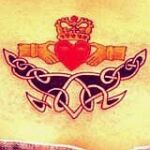 | The claddagh is an Irish symbol of love and friendship. Typically, the claddagh consists of 2 hands, a heart, and a crown. The 2 hands represent friendship, the crown loyalty, and the heart, of course, love. It eventually came to be used most regularly as a betrothal ring - invented perhaps in 1689 by a native Galway jeweler who had been captured by pirates but returned safely to his true love after 5 years away. It is a pledge of friendship, loyalty, and love and a message that the bearer is "spoken for." |
|
Clover
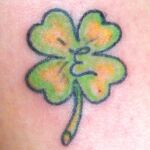 | The clover is sometimes thought of as synonymous with the shamrock, although the 2 are not actually the same. Clover is one of a group of plants (Trifolium) that are generally three-leafed. Originally, properties of the plant such as being full of life and robust came to be associated with living well and prosperously ("in clover" or "in the clover"). Clover was also planted on graves, probably as a reference to a new life either after death or at the resurrection. The notion that clover was associated with luck is the result of the 4-leaf clover, because of its rarity. Thus, a good luck tattoo is generally a 4-leaf clover. |
|
Daisy
 | Flowers are a large part of the repertoire of tattoo artwork, and just as each has its own unique look, each also has its own special meanings. The daisy (from the Old English "day's eye") is a Western symbol, native to Europe. It has come to symbolize not only the coming of spring but also youth and innocence. Daisies, with their large yellow center and white petals, are popular in tattoo art - sometimes alone, sometimes in a chain, sometimes with petals in the process of being plucked. |
|
Devil
 | The devil, or Satan, comes in a wide variety of forms in tattoo art - with batlike wings and a tail; dressed as a fine gentleman in a suit; with cloven hooves; in a grotesque vwesion of a cathedral column; as a prince - but the most common is a horned, red demon. The devil is the opposite of the divine and the antithesis of God, obviously associated with evil, but more importantly for tattoo, also associated with temptation. His entire purpose is to deprive humans of the grace of God by tempting them into sinful behaviour and causing them to give in to their base desires. |
|
Dice
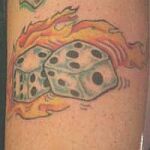 | Tattoos of dice are many times part of lucky gaming designs. In these contexts. the dice are particularly representative of risk-taking behaviour, with an uncertain outcome and in which the gambler has a stake. In the game of craps, the number 7 (achieved by adding the 2 die values together) is generally a winning and therefore lucky roll while "snake eyes" (two 1's) is almost always a losing combination. |
|
Dream Catcher
 | The dream catcher is a Native American symbol that probably originated in the northern Midwest, eventually apreading into the plains. Based on the story of how the Spider Woman captures the sunrise for people in the dew of her web, the dream catcher is in the shape of a circle to represent how the sun travels across the sky each day. Usually hung near a cradle board, the dream catcher filters out the bad dreams, allowing only good thoughts to enter through ba small hole in the center. With the first rays of sunlight, the bad dreams would perish. The points where the web connects to the hoop often number 8 for Spider Woman's 8 legs. It is also traditional to put a feather in the center of the dream catcher, symbolizing breath of air, but also meant to be entertaining for a baby to watch. |
|
Eagle
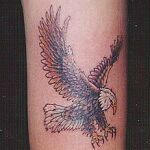 | The eagle is quite simply the king of the birds. In symbolism written or pictorial, it is representative of the mightest rulers, the highest gods, and the greatest heroes. In surviving texts from ancient Babylon, the deceased king is borne to the heavens by an eagle. In many instances, the eagle embodies lofty aspirations and higher spiritual achievement, In other cases, it symbolizes strength and glory and even substitutes for the sun in Arctic and some Native American mythology. |
|
Eye of Horus
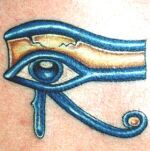 | In ancient Egypt, the eye of horus (also called the udjat or utchat or "sound eye") was a powerful symbol and protective amulet. During his battle with Seth, Horus's eye was plucked out and torn apart. But Thoth was able to piece it back together, adding a little bit of magic to it to make up for a tiny piece that was missing. As the regenerated eye of the falcon god Horus, this talisman was worn as a sacred symbol to ensure good health. |
|
| | |
|

















